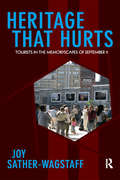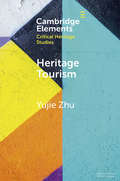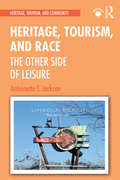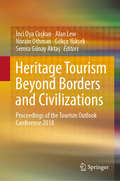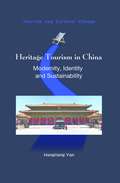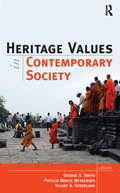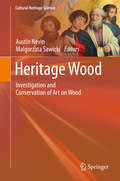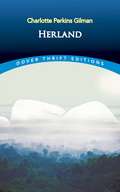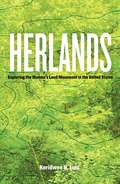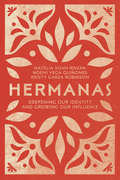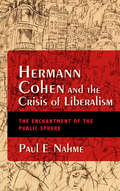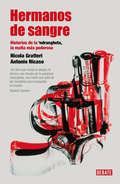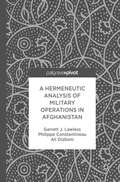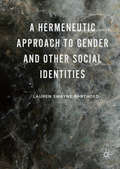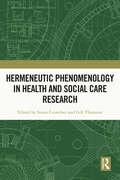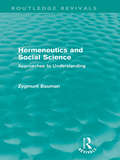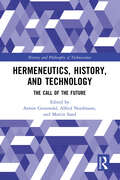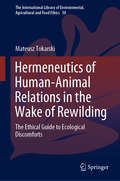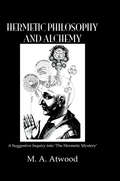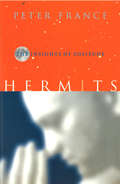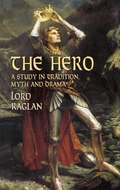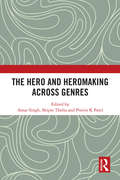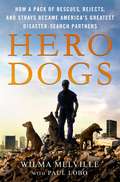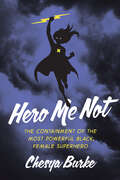- Table View
- List View
Heritage Studies 6: Ancient Civilizations Activity Manual
by Bju PressHeritage Studies Grade 6, Ancient Civilizations Activity Manual, Fourth Edition by BJU Press
Heritage That Hurts: Tourists in the Memoryscapes of September 11 (Heritage, Tourism, and Community #4)
by Joy Sather-WagstaffMemorial sites, sites of “dark tourism,” are vernacular spaces that are continuously negotiated, constructed, and reconstructed into meaningful places. Using the locale of the 9/11 tragedy, Joy Sather-Wagstaff explores the constructive role played by tourists in understanding social, political, and emotional impacts of a violent event that has ramifications far beyond the local population. Through in-depth interviews, photographs, graffiti, even souvenirs, she compares the 9/11 memorial with other hurtful sites—the Oklahoma City National Memorial, Vietnam Veteran’s Memorial, and others—to show how tourists construct and disperse knowledge through performative activities, which make painful places salient and meaningful both individually and collectively.
Heritage Tourism: From Problems to Possibilities (Elements in Critical Heritage Studies)
by Yujie ZhuAs one of the world's fastest growing industries, heritage tourism is surrounded by political and ethical issues. This research explores the social and political effects and implications of heritage tourism through several pertinent topics. It examines the hegemonic power of heritage tourism and its consequences, the spectre of nationalism and colonialism in heritage-making, particularly for minorities and indigenous peoples, and the paradox of heritage tourism's role in combating these issues. Drawing from global cases, the study addresses a range of approaches and challenges of empowerment within the context of heritage tourism, including cultural landscapes, intangible heritage and eco-museums. The research argues that heritage tourism has the potential to develop as a form of co-production. It can be used to create a mechanism for community-centred governance that integrates recognition and interpretation and promotes dialogue, equity and diversity.
Heritage, Tourism, and Race: The Other Side of Leisure (Heritage, Tourism, and Community)
by Antoinette T JacksonHeritage, Tourism, and Race views heritage and leisure tourism in the Americas through the lens of race, and is especially concerned with redressing gaps in recognizing and critically accounting for African Americans as an underrepresented community in leisure. Fostering critical public discussions about heritage, travel, tourism, leisure, and race, Jackson addresses the underrepresentation of African American leisure experiences and links Black experiences in this area to discussions of race, place, spatial imaginaries, and issues of segregation and social control explored in the fields of geography, architecture, and the law. Most importantly, the book emphasizes the importance of shifting public dialogue from a singular focus on those groups who are disadvantaged within a system of racial hierarchy, to those actors and institutions exerting power over racialized others through practices of exclusion. Heritage, Tourism, and Race will be invaluable reading for academics and students engaged in the study of museums, as well as architecture, anthropology, public history, and a range of other disciplines. It will also be of interest to museum and heritage professionals and those studying the construction and control of space and how this affects and reveals the narratives of marginalized communities.
Heritage Tourism Beyond Borders and Civilizations: Proceedings of the Tourism Outlook Conference 2018
by İnci Oya Coşkun Alan Lew Norain Othman Gökçe Yüksek Semra Günay AktaşThis book gathers the best papers presented at the 11th Tourism Outlook Conference, held in Eskişehir, Turkey, from 3 to 5 October 2018. Covering various aspects of heritage and its effects on tourism issues, the contributions provide a multidisciplinary perspective on emerging issues and challenges in the area. The book also analyzes both the tangible and intangible properties of natural, cultural, and historical heritage and how these relate to and influence tourism, and evaluates the importance and role of heritage in tourism destinations and products. By providing a platform for cross-disciplinary dialogues that integrate research and insights from diverse geographical, sectoral and institutional perspectives, the book allows readers to gain a better understanding of heritage tourism.
Heritage Tourism in China: Modernity, Identity and Sustainability
by Hongliang YanThis book offers new approaches and insights into the relationships between heritage tourism and notions of modernity, identity building and sustainable development in China. It demonstrates that the role of the state, politics, institutional arrangements and tradition have a considerable impact on perceptions of these notions. The volume contributes to current debates on tradition and modernity; the study of heritage tourism; the negotiated power between stakeholders in tourism planning and policy-making and the study of China’s society. The approach and findings of the book are of value to those interested in the continuities and changes in Chinese society and to graduate students and researchers in tourism, cultural studies and China studies.
Heritage Values in Contemporary Society
by George S Smith Hilary A Soderland Phyllis Mauch MessengerWhat do we value about the past? In formulating policies about heritage preservation, that is the inevitable question, and deals not only with economic value but also the intangible value to individuals, communities and society as a whole. This interdisciplinary group of scholars—anthropologists, archaeologists, architects, educators, lawyers, heritage administrators, policy analysts, and consultants—make the first attempt to define and assess heritage values on a local, national and global level. Chapters range from the theoretical to policy frameworks to case studies of heritage practice, written by scholars from eight countries.
Heritage Wood: Investigation and Conservation of Art on Wood (Cultural Heritage Science)
by Austin Nevin Malgorzata SawickiThis volume highlights recent research efforts in the conservation and investigation of works of art on wood. Through eleven case studies it showcases different experimental methods ranging from X-ray analysis of objects to the study of cross-sections made from micro-samples. New research focusing on the technical study, treatment and assessment of works of art on wood in its many forms is featured in this edited volume. Technical studies include the attribution and investigations of a triptych by Hans Memling and a sculpture from workshop of Michel and Gregor Erhart, decorated Syrian rooms, and investigations of finely carved Gothic wooden objects. Synchrotron-based methods are presented for studying the alteration of 19th c. verdigris in Norway, and multi-analytical methods are employed for the investigations of 16th to 19th c. East Asian lacquer from the Kunsthistorisches Museum in Vienna. Novel methods for the cleaning of gilded surfaces using gels and emulsions are shown, as are innovative strategies for the consolidation for waterlogged wood, providing key data for the assessment of risks and benefits of new methods, and the short and long-term effects on gilding layers and archaeological wood. The book clearly shows how collaboration between engineers, physicists, biologists and chemists and conservators of different types of materials can lead to new research in conservation science. This book is crucial reading for conservators and conservation scientists, as well as for technical art historians, providing key methodological case studies of polychromy from different temporal and geographical contexts.
Herland: Large Print (Dover Thrift Editions)
by Charlotte Perkins GilmanA prominent turn-of-the-century social critic and lecturer, Charlotte Perkins Gilman is perhaps best known for her short story "The Yellow Wallpaper," a chilling study of a woman's descent into insanity, and Women and Economics, a classic of feminist theory that analyzes the destructive effects of women's economic reliance on men.In Herland, a vision of a feminist utopia, Gilman employs humor to engaging effect in a story about three male explorers who stumble upon an all-female society isolated somewhere in South America. Noting the advanced state of the civilization they've encountered, the visitors set out to find some males, assuming that since the country is so civilized, "there must be men." A delightful fantasy, the story enables Gilman to articulate her then-unconventional views of male-female roles and capabilities, motherhood, individuality, privacy, the sense of community, sexuality, and many other topics.Decades ahead of her time in evolving a humanistic, feminist perspective, Gilman has been rediscovered and warmly embraced by contemporary feminists. An articulate voice for both women and men oppressed by the social order of the day, she adeptly made her points with a wittiness often missing from polemical writings. This inexpensive edition of Herland will charm readers with the tale's mischievous, ironic outlook.
Herlands: Exploring the Women's Land Movement in the United States
by Keridwen N. LuisHow women-only communities provide spaces for new forms of culture, sociality, gender, and sexuality Women’s lands are intentional, collective communities composed entirely of women. Rooted in 1970s feminist politics, they continue to thrive in a range of ways, from urban households to isolated rural communes, providing spaces where ideas about gender, sexuality, and sociality are challenged in both deliberate and accidental ways. Herlands, a compelling ethnography of women’s land networks in the United States, highlights the ongoing relevance of these communities as vibrant cultural enclaves that also have an impact on broader ideas about gender, women’s bodies, lesbian identity, and right ways of living.As a participant-observer, Keridwen N. Luis brings unique insights to the lives and stories of the women living in these communities. While documenting the experiences of specific spaces in Massachusetts, Tennessee, New Mexico, and Ohio, Herlands also explores the history of women’s lands and breaks new ground exploring culture theory, gender theory, and how lesbian identity is conceived and constructed in North America. Luis also discusses how issues of race and class are addressed, the ways in which nudity and public hygiene challenge dominant constructions of the healthy or aging body, and the pervasive influence of hegemonic thinking on debates about transgender women. Luis finds that although changing dominant thinking can be difficult and incremental, women’s lands provide exciting possibilities for revolutionary transformation in society.
Hermanas: Deepening Our Identity and Growing Our Influence
by Natalia Kohn Rivera Noemi Vega Quiñones Kristy Garza RobinsonGod calls Latinas to lives of influence. He created his Latina daughters to partner with him, live into the incredible plans he has for each of us, and walk in his grace and strength to help change this world. But many of us have heard cultural messages that make us doubt our adequacy. We have not seen many Latina women in positions of leadership, and we need more mentors and role models. Natalia Kohn, Noemi Vega Quiñones, and Kristy Garza Robinson share their own journeys as Latinas and leaders. They find mentorship in twelve inspirational women of the Bible including Esther, Rahab, Mary, and Lydia, who navigated challenges of brokenness and suffering, being bicultural, and crossing borders. As we deepen our spiritual and ethnic identities, we grow in intimacy with God and others and become better equipped to influence others for the kingdom. The insights here will help any who seek to empower Latinas in leadership. You are not alone on this journey. Join your sisters and partner with our heavenly Father as you become the Latina leader God has called you to be.
Hermann Cohen and the Crisis of Liberalism: The Enchantment of the Public Sphere (New Jewish Philosophy and Thought)
by Paul E. NahmeHermann Cohen (1842–1918) is often held to be one of the most important Jewish philosophers of the nineteenth century. Paul E. Nahme, in this new consideration of Cohen, liberalism, and religion, emphasizes the idea of enchantment, or the faith in and commitment to ideas, reason, and critique—the animating spirits that move society forward. Nahme views Cohen through the lenses of the crises of Imperial Germany—the rise of antisemitism, nationalism, and secularization—to come to a greater understanding of liberalism, its Protestant and Jewish roots, and the spirits of modernity and tradition that form its foundation. Nahme’s philosophical and historical retelling of the story of Cohen and his spiritual investment in liberal theology present a strong argument for religious pluralism and public reason in a world rife with populism, identity politics, and conspiracy theories.
Hermanos de sangre: Historias de la 'Ndragheta la mafia más poderosa
by Nicola GratteriLa extraordinaria reconstrucción del universo criminal de la 'Ndrangheta', la mafia más poderosa y desconocida. La 'Ndrangheta calabresa siempre ha sido infravalorada, considerada un fenómeno criminal menor, casi folclórico. Solo sale a la luz pública en momentos de sanguinaria celebridad, como ocurrió en Duisburgo (Alemania) en 2007, en un salvaje ajuste de cuentas en el que murieron seis personas. Crecida y fortalecida en el silencio, tiene hoy ramificaciones en todas las regiones italianas y en los cinco continentes y contactos con las principales organizaciones terroristas y criminales del mundo. Nicola Gratteri y Antonio Nicaso son los mayores expertos mundiales sobre esta organización criminal, cuya evolución no ha anulado los antiguos rituales, que han sido readaptados, pero nunca descartados. Una liturgia en la que conviven el arcángel san Miguel y mitos ancestrales, invocaciones improbables al Evangelio y a la religión cristiana, y pintorescos rituales de iniciación centrados en el protagonismo del «vínculo de sangre». Un universo simbólico que puede parecer extraño e incluso delirante, pero que resulta muy útil para conservar una sola identidad en cualquier lugar y ocasión. Gratteri y Nicaso han logrado una extraordinaria reconstrucción de la historia y la atmósfera de un universo criminal de asombroso alcance y brutalidad. Reseñas:«El libro que revela la sangre, el dinero y los rituales de la poderosa 'Ndrangheta, una mafia que salió de las montañas para conquistar el mundo.»Roberto Saviano «La obra máxima, la piedra angular de lo que concierne a la 'Ndrangheta y su escalada al poder mundial de las organizaciones criminales.»Benny Calasanzio Borsellino
A Hermeneutic Analysis of Military Operations in Afghanistan
by Garrett J. Lawless Philippe Constantineau Ali DizboniThis book introduces the field of hermeneutics through a critique of military operations in Afghanistan. Following a brief survey of modern political history of the country, the authors examine the link between cultural factors and the inefficiency of nation-building operations. Additionally, the project discusses contending academic approaches to culture, and identifies shortcomings in their theoretical propositions for military operations in failed states. Ultimately, this volume contextualizes the evolution of hermeneutical thinking and the benefits it provides in assessing the transformation of culture through military intervention.
A Hermeneutic Approach to Gender and Other Social Identities
by Lauren Swayne BartholdThis book draws on the hermeneutics of Hans-Georg Gadamer to inform a feminist perspective of social identities. Lauren Swayne Barthold moves beyond answers that either defend the objective nature of identities or dismiss their significance altogether. Building on the work of both hermeneutic and non-hermeneutic feminist theorists of identity, she asserts the relevance of concepts like horizon, coherence, dialogue, play, application, and festival for developing a theory of identity. This volume argues that as intersubjective interpretations, social identities are vital ways of fostering meaning and connection with others. Barthold also demonstrates how a hermeneutic approach to social identities can provide critiques of and resistance to identity-based oppression.
Hermeneutic Phenomenology in Health and Social Care Research
by Susan Crowther Gill ThomsonThis book explores how, why, and when hermeneutic phenomenology can be used as methodology in health and social research. Providing actual examples of doing robust hermeneutic phenomenology and a focus on praxis, the book demonstrates how philosophical or theoretical notions can inform, enrich and enhance our research projects. The chapters offer examples of many different research designs and interpretive decisions in order to illustrate the unbounded and creative nature of this type of inquiry, whilst also demonstrating the trustworthiness of the scientific processes adopted. The chapter authors invite the reader on a unique journey that highlights how they made individual and tailored decisions throughout their projects, emphasising the challenges and joys they encountered. This book is a valuable resource for all students and academics who wish to explore the meaningfulness of human lived experiences across the multitude of phenomena in health and social care.
Hermeneutics and Social Science: Approaches to Understanding (Routledge Revivals)
by Zygmunt BaumanOriginally published in 1978, this important work, by one of the leading European social theorists, is arguably the best introduction to the hermeneutic tradition as a whole. It is designed to help students of sociology and philosophy place the problems of "understanding social science" in their historical and philosophical context. It does so by presenting the major current in sociological thought as responses to the challenge of hermeneutics. The idea that true knowledge of social life can be attained only if human conduct is seen as meaningful action whose meaning is accordingly grasped has been presented as a discovery of recent sociology. In fact its history is long and its connections plentiful, reaching beyond the boundaries of sociology itself. Yet it is in sociology that the hermeneutic tradition has attracted most interest but most misinterpretation. The debate is in full swing and there is no attempt to offer "correct" solutions - the emphasis instead is upon revealing the strengths and weaknesses of each of the main approaches. However it is Bauman's view that the theory of understanding may achieve valid results only if it treats the problem of understanding as an aspect of the ongoing process of social life.
Hermeneutics, History, and Technology: The Call of the Future (History and Philosophy of Technoscience)
by Armin Grunwald Alfred Nordmann Martin SandFor better and worse, the future is often conceived in technological terms. Technology is supposed to meet the challenge of climate change or resource depletion. And when one asks about the world in 20 or 100 years, answers typically revolve around AI, genome editing, or geoengineering. There is great demand to speculate about the future of work, the future of mobility, Industry 4.0, and Humanity 2.0. The humanities and social sciences, science studies, and technology assessment respond to this demand but need to seek out a responsible way of taking the future into account. This collection of papers, interviews, debates grew out of disagreements about technological futures, speculative ethics, plausible scenarios, anticipatory governance, and proactionary and precautionary approaches. It proposes Hermeneutic Technology Assessment as a way of understanding ourselves through our ways of envisioning the future. At the same time, a hermeneutic understanding of technological projects and prototypes allows for normative assessments of their promises. Is the future an object of design? This question can bring together and divide policy makers, STS scholars, social theorists, and philosophers of history, and it will interest also the scientists and engineers who labor under the demand to deliver that future.
Hermeneutics of Human-Animal Relations in the Wake of Rewilding: The Ethical Guide to Ecological Discomforts (The International Library of Environmental, Agricultural and Food Ethics #30)
by Mateusz TokarskiIn consequence of significant social, political, economic, and demographic changes several wildlife species are currently growing in numbers and recolonizing Europe. While this is rightly hailed as a success of the environmental movement, the return of wildlife brings its own issues. As the animals arrive in the places we inhabit, we are learning anew that life with wild nature is not easy, especially when the accumulated cultural knowledge and experience pertaining to such coexistence have been all but lost. This book provides a hermeneutic study of the ways we come to understand the troubling impacts of wildlife by exploring and critically discussing the meanings of 'ecological discomforts'. Thus, it begins the work of rebuilding the culture of coexistence. The cases presented in this book range from crocodile attacks to mice infestations, and their analysis consequently builds up an ethics that sees wildlife as active participants in the shaping of human moral and existential reality. This book is of interest not only to environmental philosophers, who will find here an original contribution to the established ethical discussions, but also to wildlife managers, and even to those members of the public who themselves struggle to make sense of encounters with their new wild neighbors.
Hermetic Philosophy & Alchemy
by AtwoodThis is a reprint of the 1920 edition of an important but almost unknown work. When Atwood made her suggestive inquiry into what was termed "The Hermetic Mystery," she supposed that the adept Hieophants put the candidate into a deep trance and his soul was led into something that was for her the Supreme Oneness of everything.
Hermits: The Insights of Solitude
by Peter FranceOurs is an age where solitude tends to be discussed in the context of the 'problem of loneliness'. However in previous ages the capacity to seek fulfillment outside society has been admired and seen as a measure of discernment and inner security. In this lucid and highly readable book, Peter France shows how hermits, from the Taoists and Ancient Greeks to the present day, have something vitally important to say to a society that fears solitude.
The Hero: A Study in Tradition, Myth and Drama (Dover Books On Anthropology, Folklore And Myths)
by Lord RaglanHis mother is a virgin and he's reputed to be the son of a god; he loses favor and is driven from his kingdom to a sorrowful death — sound familiar? In The Hero, Lord Raglan contends that the heroic figures from myth and legend are invested with a common pattern that satisfies the human desire for idealization. Raglan outlines 22 characteristic themes or motifs from the heroic tales and illustrates his theory with events from the lives of characters from Oedipus (21 out of a possible 22 points) to Robin Hood (a modest 13). This new edition of The Hero (which originally appeared some 13 years before Joseph Campbell's The Hero with a Thousand Faces) is assured of a lasting popularity. This book will appeal to scholars of folklore and mythology, history, literature, and general readers as well.
The Hero and Hero-Making Across Genres
by Amar Singh Shipra Tholia Pravin K PatelThis book critically examines how a Hero is made, sustained, and even deformed, in contemporary cultures. It brings together diverse ideas from philosophy, mythology, religion, literature, cinema, and social media to explore how heroes are constructed across genres, mediums, and traditions. The essays in this volume present fresh perspectives for readers to conceptualize the myriad possibilities the term ‘Hero’ brings with itself. They examine the making and unmaking of the heroes across literary, visual and social cultures —in religious spaces and in classical texts; in folk tales and fairy tales; in literature, as seen in Heinrich Böll’s Und Sagte Kein Einziges Wort, Thomas Brüssig’s Heroes like Us, and in movies, like Christopher Nolan’s Interstellar, Michel Gondry’s Eternal Sunshine of the Spotless Mind and in the short film like Dean Potter's When Dogs Fly. The volume also features nuanced takes on intersectional feminist representations in hero movies; masculinity in sports biopics; taking everyday heroes from the real to the reel, among others key themes. A stimulating work that explores the mechanisms that ‘manufacture’ heroes, this book will be useful for scholars and researchers of English literature, postcolonial studies, cultural studies, film studies, media studies, literary and critical theory, arts and aesthetics, political sociology and political philosophy.
Hero Dogs: How a Pack of Rescues, Rejects, and Strays Became America's Greatest Disaster-Search Partners (Dog Heroes Ser.)
by Paul Lobo Wilma MelvilleLola was a buckshot-riddled stray, lost on a Memphis highway. Cody was rejected from seven different homes. Ace had been sprayed with mace and left for dead on a train track. They were deemed unadoptable. Untrainable. Unsalvageable. These would become the same dogs America relied on when its worst disasters hit.In 1995, Wilma Melville volunteered as a canine search-and-rescue (SAR) handler with her Black Labrador Murphy in the aftermath of the Oklahoma City bombing. At the time, there were only fifteen FEMA certified SAR dogs in the United States. Believing in the value of these remarkable animals to help save lives, Wilma knew many more were needed in the event of future major disasters. She made a vow to help 168 dogs receive search-and-rescue training in her lifetime—one for every Oklahoma City victim.Wilma singlehandedly established the National Disaster Search Dog Foundation (SDF) to meet this challenge. The first canine candidates—Ana, Dusty, and Harley—were a trio of golden retrievers with behavioral problems so severe the dogs were considered irredeemable and unadoptable. But with patience, discipline, and love applied during training, they proved to have the ability, agility, and stamina to graduate as SARs. Paired with a trio of firefighters, they were among the first responders searching the ruins of the World Trade Center following 9/11—setting the standard for the more than 168 of the SDF’s search-and-rescue dogs that followed. Beautiful and heart-wrenching, Hero Dogs is the story of one woman’s dream brought to fruition by dedicated volunteers and firefighters—and the bonds they forged with the incredible rescued-turned-rescuer dogs to create one of America’s most vital resources in disaster response.
Hero Me Not: The Containment of the Most Powerful Black, Female Superhero
by Chesya BurkeFirst introduced in the pages of X-Men, Storm is probably the most recognized Black female superhero. She is also one of the most powerful characters in the Marvel Universe, with abilities that allow her to control the weather itself. Yet that power is almost always deployed in the service of White characters, and Storm is rarely treated as an authority figure. Hero Me Not offers an in-depth look at this fascinating yet often frustrating character through all her manifestations in comics, animation, and films. Chesya Burke examines the coding of Storm as racially “exotic,” an African woman who nonetheless has bright white hair and blue eyes and was portrayed onscreen by biracial actresses Halle Berry and Alexandra Shipp. She shows how Storm, created by White writers and artists, was an amalgam of various Black stereotypes, from the Mammy and the Jezebel to the Magical Negro, resulting in a new stereotype she terms the Negro Spiritual Woman. With chapters focusing on the history, transmedia representation, and racial politics of Storm, Burke offers a very personal account of what it means to be a Black female comics fan searching popular culture for positive images of powerful women who look like you.

